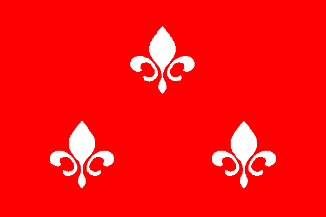 Shipmate Flagchart : http://www.shipmate.nl/flags.htm
Shipmate Flagchart : http://www.shipmate.nl/flags.htm

Last modified: 2004-07-10 by jarig bakker
Keywords: beverwijk |
Links: FOTW homepage |
search |
disclaimer and copyright |
write us |
mirrors
 Shipmate Flagchart : http://www.shipmate.nl/flags.htm
Shipmate Flagchart : http://www.shipmate.nl/flags.htm
The flag, adopted 9 Oct 1948, is derived from the top of the municipal
CoA. The lilies are a typical phenomenon of "Kennemerland" (the area around
Haarlem). Sierksma's Nederlands vlaggenboek, 1962, has slightly different
lilies (more French); that flag was adopted 8 Oct 1948.
Jarig Bakker, 10 July 2001
The reference to beavers is probably incorrect, please include the information
on the website of Beverwijk municipality:
"Does Beverwijk have anything to do with beavers?
The idea that Beverwijk (The word 'Beverwijk' literally means
'beaver area') got its name from the fact that many beavers used to live
here is perhaps a nice one, but is not very likely. No remains of beavers'
bones have ever been found at archaeological excavations. There are many
theories about the origins of the name and detailed historical studies
are still being carried out. Beverwijk definitely has a connection with
the name Agatha. You are forever coming across different versions of that
name. In the middle of town you will immediately notice the Aagtendorp
housing development, with its unusual design and use of colour. Sint Aagtendijk
- an 800-year-old dyke – leads from the town centre to the residential
areas Zwaansmeer and Oosterwijk. Between the fields and meadows of the
Wijkermeerpolder is the military fort Sint Aagtendijk, part of a circular
line of defence that was built in the 19th century to protect Amsterdam.
And, of course, the Agathakerk church in the Breestraat, whose dome is
a distinct part of the Beverwijk skyline. Aagtendorp, Aagtenhal, Agathakerk,
Sint Aagtendijk fort, Sint Aagtendijk - it must be more than coincidence.
A much-supported theory, although not proven, is that a certain St. Agatha can give us an explanation for the name Beverwijk. In the early Middle Ages (1063) there was a church, or perhaps a chapel, in this area called the Agathenkiricha. This church or chapel was named after St. Agatha. Despite the R